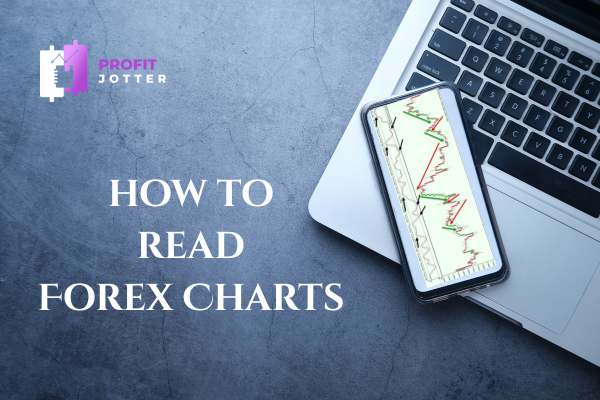Forex charts can be overwhelming for beginners, but understanding them is important for anyone venturing into the world of currency trading.
These charts are like the language of the forex market, helping traders analyze price movements and make informed decisions.
In this beginner-friendly guide, I explained the different types of charts, its components, and how to interpret key patterns.
So, let’s dive in and explain forex charts and unlock their potential to enhance your trading journey.
What Are Forex Charts?
Forex charts are graphical displays of the price movements of currency pairs over a certain period.
Each chart tracks how one currency performs relative to another, like the EUR/USD pair (Euro vs. US Dollar).
They provide traders with real-time and historical data, making it easier to make informed decisions.
Forex charts visually display how currency pairs have performed over time, offering insights into trends, reversals, and market momentum.
Whether you’re glancing at a line chart for simplicity or diving into candlestick patterns for deeper analysis, forex charts are a trader’s roadmap.
At their core, Forex charts answer three questions:
→ Where has the price been?
→ Where is the price now?
→ Where could the price go next?
You can practise how Forex charts work using MT4 or MT5.
Open a demo account on platforms like MetaTrader 4 or MetaTrader 5 to practice analyzing charts without risking real money.
You can also use tools like TradingView or the in-built software on trading platforms to access real-time charts with customizable features.
Types of Forex Charts
Forex platforms usually offer three main types of charts. Here’s what they look like and how they work.
→ Line Charts
A line chart is the simplest form.
It connects the closing prices of a currency pair with a straight line, providing a clear overview of the market’s overall trend.
→ Bar Charts
Bar charts, also known as OHLC charts (Open, High, Low, Close), provide more details about a trading period.
It shows the following:
- Open Price: The horizontal line on the left.
- Close Price: The horizontal line on the right.
- High and Low Prices: The vertical bar.
Bar charts are popular with traders looking for more in-depth analysis.
→ Candlestick Charts
Candlestick charts are the most widely used and beginner-friendly.
They represent price movements through colorful “candles” that show the open, high, low, and close prices for a given period.
It indicates the following:
- A green/white candle means the price increased (bullish).
- A red/black candle means the price decreased (bearish).
The “body” shows the range between the open and closed prices, while the “wicks” or “shadows” show the high and low points.
Understanding Timeframes
Forex charts can display data over various timeframes, ranging from 1 minute to 1 month.
The timeframe you select depends on your trading strategy:
→ Scalpers: Prefer 1-5 minute charts for quick trades.
→ Day Traders: Use 15-minute to 1-hour charts for short-term trades.
→ Swing Traders: Favor 4-hour to daily charts for medium-term positions.
→ Position Traders: Opt for weekly or monthly charts for long-term analysis.
Key Components of Forex Charts
Here’s how to decode the main elements of a Forex chart:
→ Currency Pair
The top of the chart displays the currency pair, e.g., USD/JPY (US Dollar vs. Japanese Yen). Always know which currency you’re analyzing.
→ Price Axis (Y-Axis)
The vertical axis represents the price level of the currency pair.
→ Time Axis (X-Axis)
The horizontal axis indicates the timeframe, showing the progression of price movements over minutes, hours, days, or months.
→ Volume
Many charts also show trading volume, indicating how many traders are buying or selling. Higher volume often signifies stronger trends.
Why Forex Charts Are Important
Forex charts are indispensable tools for traders. They help you:
→ Visualize the market’s movements.
→ Identify profitable entry and exit points.
→ Make data-driven trading decisions.
→ Without a good grasp of Forex charts, trading becomes guesswork. The more you practice, the better you’ll get at spotting opportunities.
How to Interpret Forex Charts
Understanding Forex charts involves recognizing patterns and trends.
Here’s how:
→ Identifying Trends
Uptrend: Higher highs and higher lows. Indicates bullish sentiment.
Downtrend: Lower highs and lower lows. Indicates bearish sentiment.
Sideways Trend: Prices move in a range without a clear direction.
→ Support and Resistance Levels
Support: A price level where demand is strong enough to prevent further decline.
Resistance: A price level where selling pressure prevents further rise. Learning to identify these levels helps you anticipate price reversals.
→ Candlestick Patterns
Candlesticks can reveal patterns that predict price movements:
Bullish Patterns: Hammer, Morning Star, Engulfing.
Bearish Patterns: Shooting Star, Evening Star, Engulfing.
→ Indicators
Indicators like moving averages, RSI, and MACD can enhance your chart analysis by confirming trends or highlighting momentum shifts.
Why Forex Charts Are Important
Forex charts are indispensable tools for traders. They help you:
→ Visualize the market’s movements.
→ Identify profitable entry and exit points.
→ Make data-driven trading decisions.
→ Without a good grasp of Forex charts, trading becomes guesswork. The more you practice, the better you’ll get at spotting opportunities.
Common Mistakes to Avoid
→ Overloading Charts
Adding too many indicators can lead to confusion, so stick to a few that complement your trading style.
→ Ignoring Timeframes
Always match your chart analysis with your trading timeframe. Using the wrong timeframe can result in poor decisions.
→ Chasing Trends
Don’t jump into trades based solely on recent trends. Look for confirmation through multiple signals.
Conclusion
Understanding how to read forex charts is important for anyone looking to enter the world of forex trading.
When the basics of forex charts have been mastered, then traders can make informed decisions.
Forex charts act as a roadmap, providing insights into past and potential future market movements, and helping traders spot profitable opportunities.
While it may seem intimidating at first, consistent practice and patience can make chart reading second nature.
Beginners are encouraged to start with a demo account to familiarize themselves with various chart types and tools without the risk of financial loss.
As you grow in confidence, integrating advanced indicators can further refine your strategies.
Remember, successful trading isn’t just about reading charts; it’s about discipline, continuous learning, and adapting to the ever-changing market.



